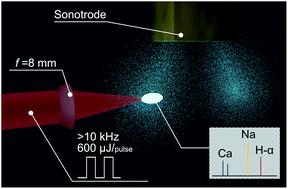当前位置:
X-MOL 学术
›
J. Anal. At. Spectrom.
›
论文详情
Our official English website, www.x-mol.net, welcomes your
feedback! (Note: you will need to create a separate account there.)
High-throughput underwater elemental analysis by μJ-laser-induced breakdown spectroscopy at kHz repetition rates: part I, ultrasound-enhanced optical emission spectroscopy towards application perspectives
Journal of Analytical Atomic Spectrometry ( IF 3.1 ) Pub Date : 2020-09-18 , DOI: 10.1039/d0ja00290a Boyang Xue 1, 2, 3, 4, 5 , Yi You 4, 5, 6 , Igor Gornushkin 4, 5, 6 , Ronger Zheng 1, 2, 3 , Jens Riedel 4, 5, 6
Journal of Analytical Atomic Spectrometry ( IF 3.1 ) Pub Date : 2020-09-18 , DOI: 10.1039/d0ja00290a Boyang Xue 1, 2, 3, 4, 5 , Yi You 4, 5, 6 , Igor Gornushkin 4, 5, 6 , Ronger Zheng 1, 2, 3 , Jens Riedel 4, 5, 6
Affiliation

|
In recent years, laser-induced breakdown spectroscopy (LIBS) has gained significant attention as a means for simple elemental analyses. The suitability of LIBS for contactless analysis allows it to be a perfect candidate for underwater applications. While the majority of LIBS systems still rely upon sub-kHz pulsed lasers, this contribution introduces 10s-kHz low pulse-energy lasers into underwater LIBS to improve the throughput and statistical validity. Interestingly, the spectral component significantly changed above a critical laser repetition-rate threshold. Spectral lines of atomic hydrogen and oxygen stemming from water become visible beyond a ∼10 kHz repetition rate. This observation suggests a different plasma dynamic compared to low repetition rates. When the pulse-to-pulse interval becomes sufficiently short, a cumulative effect begins to be significant. Apparently, the new phenomena occur on a timescale corresponding to a threshold rate of ∼10 kHz, i.e. ∼100 μs. Analytically, the high repetition rates result in improved statistical validity and throughput. More plasma events per unit time allowed the use of low efficiency Echelle spectrometers without compromising on the analytical performance. Meanwhile, the presence of H I and O I out of the water (as the matrix) also offers internal standardization in underwater elemental analysis. Since the laser fluence was on the lower edge of the plasma threshold, an additional ultrasound source was introduced to induce external perturbation, which significantly improved the plasma formation stability. A huge advantage of LIBS is the possibility of detecting almost all elements within a sample simultaneously. Throughout the periodic table, chlorine is one of the most challenging elements. Consequently, Ca2+ and Na+ were used as samples to demonstrate the capability of this high repetition-rate LIBS platform. As an ambitious benchmark for our system, chlorine detection in water was also discussed.
中文翻译:

μJ激光诱导击穿光谱法以kHz重复频率进行高通量水下元素分析:第一部分,面向应用前景的超声增强光发射光谱法
近年来,作为简单元素分析的手段,激光诱导击穿光谱法(LIBS)受到了广泛关注。LIBS对于非接触式分析的适用性使其成为水下应用的理想选择。尽管大多数LIBS系统仍依赖亚kHz脉冲激光,但这种贡献将10s kHz低脉冲能量激光引入水下LIBS,以提高吞吐量和统计有效性。有趣的是,光谱分量在临界激光重复速率阈值以上显着变化。超过10 kHz的重复频率,可见到的水原子氢和氧原子的光谱线。该观察结果表明与低重复率相比,血浆动力学有所不同。当脉冲间隔足够短时,累积效应开始显着。显然,新现象发生在对应于约10 kHz阈值速率的时间尺度上,即约100μs。从分析上讲,高重复率可提高统计的有效性和吞吐量。每单位时间更多的等离子体事件允许使用低效率的Echelle光谱仪,而不会影响分析性能。同时,水中和水中的HI和OI的存在(作为基质)也为水下元素分析提供了内部标准化。由于激光能量密度在等离子体阈值的下边缘,因此引入了一个额外的超声源以引起外部扰动,从而显着提高了等离子体形成的稳定性。LIBS的巨大优势在于可以同时检测样品中几乎所有元素。在整个元素周期表中,氯是最具挑战性的元素之一。因此,Ca 2+Na +和Na +被用作样品,以证明该高重复率LIBS平台的功能。作为我们系统的雄心勃勃的基准,还讨论了水中氯的检测。
更新日期:2020-11-03
中文翻译:

μJ激光诱导击穿光谱法以kHz重复频率进行高通量水下元素分析:第一部分,面向应用前景的超声增强光发射光谱法
近年来,作为简单元素分析的手段,激光诱导击穿光谱法(LIBS)受到了广泛关注。LIBS对于非接触式分析的适用性使其成为水下应用的理想选择。尽管大多数LIBS系统仍依赖亚kHz脉冲激光,但这种贡献将10s kHz低脉冲能量激光引入水下LIBS,以提高吞吐量和统计有效性。有趣的是,光谱分量在临界激光重复速率阈值以上显着变化。超过10 kHz的重复频率,可见到的水原子氢和氧原子的光谱线。该观察结果表明与低重复率相比,血浆动力学有所不同。当脉冲间隔足够短时,累积效应开始显着。显然,新现象发生在对应于约10 kHz阈值速率的时间尺度上,即约100μs。从分析上讲,高重复率可提高统计的有效性和吞吐量。每单位时间更多的等离子体事件允许使用低效率的Echelle光谱仪,而不会影响分析性能。同时,水中和水中的HI和OI的存在(作为基质)也为水下元素分析提供了内部标准化。由于激光能量密度在等离子体阈值的下边缘,因此引入了一个额外的超声源以引起外部扰动,从而显着提高了等离子体形成的稳定性。LIBS的巨大优势在于可以同时检测样品中几乎所有元素。在整个元素周期表中,氯是最具挑战性的元素之一。因此,Ca 2+Na +和Na +被用作样品,以证明该高重复率LIBS平台的功能。作为我们系统的雄心勃勃的基准,还讨论了水中氯的检测。











































 京公网安备 11010802027423号
京公网安备 11010802027423号